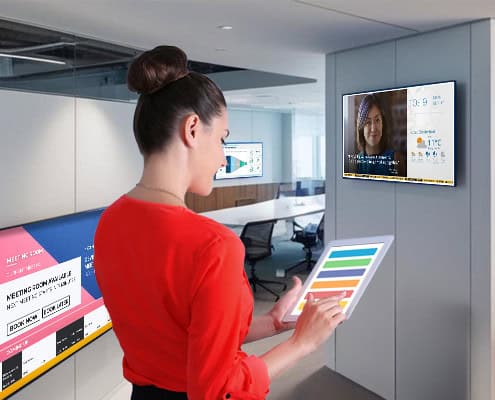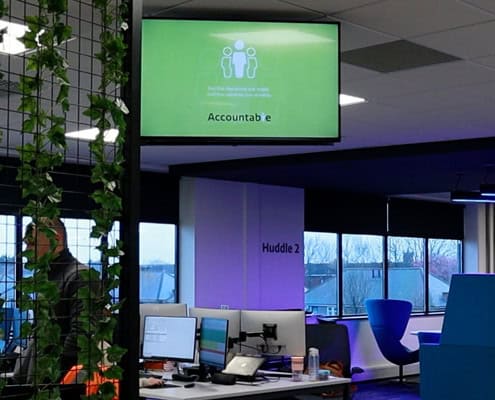
Digital Signage is a powerful communication tool that can transform the way organisations interact with their employees, customers, and visitors. But with great power comes great responsibility. As an IT manager, it’s your job to ensure that your Digital Signage solution is secure and that your organisation’s sensitive data is protected. In this article, we’ll take a look at the top security features workplace Digital Signage should have.
1/ Secure Logins
The first line of defence for any Digital Signage solution is secure logins. Your solution should require strong passwords, and ideally, offer two-factor authentication. This can prevent unauthorised access and protect your organisation’s sensitive data.
To give you more choice and flexibility, some content management systems (CMS) now ensure compatibility with a range of popular authentication apps, including Google Authenticator and Authy.
2/ User Permissions
Not everyone in your organisation needs access to every feature of your Digital Signage solution. A secure Digital Signage solution should offer user permissions, allowing you to control who can access what features. For example, you may want to restrict access to content creation tools or analytics data to a select group of users.
3/ Encryption
Encryption is essential for protecting your organisation’s data from unauthorised access. Your Digital Signage solution should encrypt all data in transit and at rest. Look for a solution that uses strong encryption standards and that has been independently audited and certified.
ISO-27001-certified CMS providers offer some of the most secure CMS platforms, having been verified to be able to protect large volumes of data. CMS solutions, such as Signagelive are also independently pentested every four months to check for any potential vulnerabilities in the system. For optimal security, data, including user passwords, is encrypted in transit as well as at rest.
4/ Data Backups
In the event of a security breach, data loss can be catastrophic. A secure Digital Signage solution should offer regular data backups to ensure that your data is protected. Backups should be stored securely and should be easy to restore in the event of data loss.
CMS solutions can automatically back up customer data on hosted applications on a daily basis.
5/ Compliance
Depending on your industry and location, your Digital Signage solution may need to comply with certain regulations like GDPR or HIPAA. A secure Digital Signage solution should be designed with compliance in mind, with features like data retention policies, data access controls, and auditing capabilities.
CMS solutions like Signagelive regularly update their practices to ensure they are always GDPR compliant. This includes putting methods and processes in place to honour Subject Access Requests (SAR), continuously reviewing and updating their privacy policies and delivering on-going data protection training to all their staff.

6/ Automatic Updates
Security vulnerabilities can arise from outdated software or firmware. A secure Digital Signage solution should offer automatic updates to ensure that your software and firmware are always up to date. Updates should be tested and vetted before deployment and should not interfere with your Digital Signage content or scheduling.
Consider investing in a Cloud-based CMS platform, which can offer automatic software and support updates, as well as security and maintenance checks.
7/ Remote Monitoring and Management
A secure Digital Signage solution should offer remote monitoring and management capabilities. This can help you identify and address security issues quickly, without the need for on-site visits. Look for a solution that offers real-time monitoring, alerting, and remote management features.
Integrated cloud-based CMS functionality, such as Proactive Monitoring https://signagelive.com/portfolio-item/proactive-monitoring/ enables you to sign up to an optional email or text alert to keep you informed about any issue, such as player outages, when you’re not logged into your CMS platform.
With cloud-based Digital Signage solutions, users have more control over their networks. Advanced editing tools, for example, allow live content to be edited on the fly.
8/ Physical Security
Digital Signage hardware is vulnerable to physical theft and tampering. A secure Digital Signage solution should include physical security features like locking enclosures, anti-tamper mechanisms, and secure mounting brackets. These features can help to deter theft and protect your organisation’s investment.
9/ Third-Party Integrations
Your Digital Signage solution may integrate with third-party applications like social media platforms or content delivery networks. A secure Digital Signage solution should ensure that these integrations are secure, with features like encryption and data access controls. Look for a solution that is compatible with popular third-party applications, and that offers secure integrations.
CMS solutions like Signagelive protect APIs with strong authentication and authorisation procedures, using JWT tokens.
10/ Support and Training
Even with the best security features, there is always a risk of human error. A secure Digital Signage solution should offer support and training to help your team understand how to use the solution securely. Look for a solution that offers training materials, user guides, and dedicated support teams.
CMS solutions can now offer a range of support, with packages that include training, as well as a free-to-access learn hubs, that provide a whole host of online educational materials.
In conclusion, security is a critical consideration for any workplace Digital Signage solution. With the right security features in place, you can protect your organisation’s data, prevent unauthorised access, and ensure that your Digital Signage solution is compliant with relevant regulations. By choosing a solution that offers these top security features, you can create a secure and effective communication tool for your organisation.




You must be logged in to post a comment.